 |
 |
 |
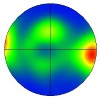 |
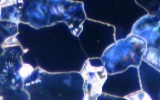 |
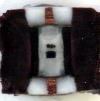 |
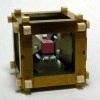 |
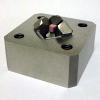 |
|
Rheology of Deep Mantle & Planetary MineralsI. Rheological Properties
|
|||||||||||||||||||||||||||||||||||||||||||||||||||||||||||||||||||||||||||||||||||||||||||||||||
【Significance】 Rheological properties of deep mantle & planetary minerals are important in understanding the Earth & planetary evolution because the Earth & planets has thermally and chemically evolved through mantle convection. The mantle convection is closely related to three-dimensional distribution of the mantle viscosity. Moreover, flow geometry of the mantle convection can be mapped by interpreting seismic anisotropy based on crystallographic preferred orientation (CPO) of the minerals. 【Approach】 We have studied the rheological properties of the deep mantle minerals by high-pressure deformation experiments. The deformation expriments should be performed at high pressure and temperature because those are high in the Earth's interior (e.g. 13.4 GPa at 400 km depth). 【State of the Art】 However, almost nothing has (had) been known about the rheological properties of the deep mantle minerals at the Earth’s deep upper mantle, mantle transition zone and lower mantle. Consequently, I have experimentally investigated their rheological properties at the region. 【Minerals of Interest】 olivine, wadsleyite, (hydrous) ringwoodite, bridgmanite (Mg-perovskite), ferropericlase, majorite, akimotoite, etc. (high-pressure minerals) Fig. (1st) Conceptual illustration of the mantle convection. (2nd) Deep mantle minerals (olivine, wadsleyite, ringwoodite, bridgmanite and majorite). (3rd) Pressure-temperature conditions in the Earth's interior. Pressure value is from Dziewonski and Anderson (1981). Temperature value is from Akaogi et al. (1989). |
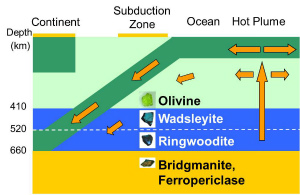 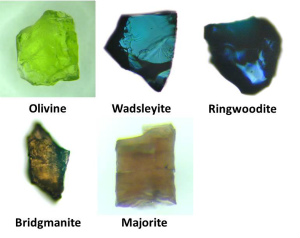 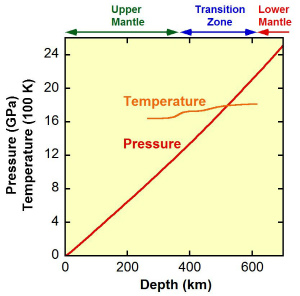 |
1. Viscosity (Creep Strength)/ Mantle Convection |
|
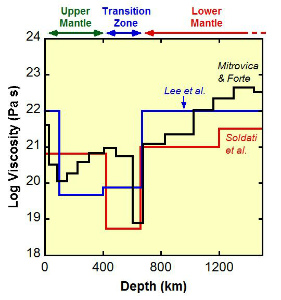   |
【Objectives】 ・"Mineralogical Viscosity Model" ・Finding viscosity anomaly Q: Low viscosity region? High viscosity region? ・Roles of the anomaly in the Earth's evolution (convection) 【State of the Art】 Viscosity of the depp mantle has been determined by geophysical observations. Nevertheless, there is large discrepancy among the geophysical models. This fact indicates necessity of mineralogical approach to determination of the mantle viscosity. 【Target】 ・Flow law (consititutive equation) ・Dislocation (active slip system, dislocation hydration) 【Mineral】 ・Olivine (the upper mantle) ・Wadsleyite (the upper part of the mantle transition zone) ・Ringwoodite (the lower part of the mantle transition zone) ・Bridgmanite (the lower mantle, in future) (high-pressure minerals) 【Achievement】(so far in 2015) ・Viscosity (creep strength) of wadsleyite is comparable with that of olivine at 14-17 GPa, 1700-2100 K and water-poor condition. (Kawazoe et al., 2010 JGR, Free!) ・Viscosity (creep strength) of olivine increases with depth (pressure) at water-poor condition. (Kawazoe et al., 2009) ・Technical development we made will be introduced below. (e.g. Kawazoe et al., 2011) Fig. (Upper) Depth profiles of the mantle viscosity (Mitrovica and Forte, 2004; Soldati et al., 2009; Lee et al., 2011). Data of Soldati et al. (2011) are normalized as 1021 Pa s at 660-1200 km depth. This figure is modified from Kawazoe (2014) (in Japanese). (Middle) Creep strength of wadsleyite (Kawazoe et al. 2010). (Lower) Creep strength of olivine at high pressure (Kawazoe et al., 2009). |
2. Crystallographic Preferred Orientation/ Seismic Anisotropy |
|
 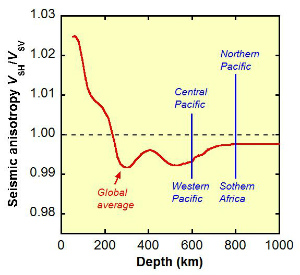  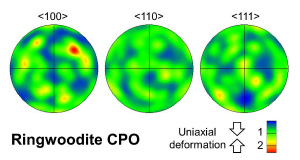 |
【Objectives】 ・"Mineralogical Seismic Anisotropy Model" ・Interpretation of anisotropic structures to mantle flows ・Finding anomalies in water content or temperature Q: Wet region? Dry region? Q: Cold region? Hot region? (This should correlate with the viscosity anomaly.) 【Target】 ・Crystallographic Preferred Orientation (CPO) pattern ・The easiest slip sytem of dislocation 【Mineral】 ・Olivine (the upper mantle) ・Wadsleyite (the upper part of the mantle transition zone) ・Ringwoodite (the lower part of the mantle transition zone) ・Bridgmanite (the lower mantle) (high-pressure minerals) 【Achievement】(so far in 2015) ・A CPO pattern of wadsleyite clearly develops. (as a left figure; Kawazoe et al., 2013) ・A CPO pattern of ringwoodite does not clearly develop. (as a left figure; Kawazoe et al., 2010 JES) ・CPO transitions in olivine (e.g. Ohuchi, Kawazoe et al., 2011) Fig. (1st) Seismic anisotropy is detected around a subsucting slab (orange area) at the deep mantle by the shear-wave splitting analysis. This figure is modified from Kawazoe (2014) (in Japanese) (2nd) Seismic anisotropy, VSH/VSV, as a function of depth. Regional variations in the seismic anisotropy are shown at 600 km and 800 km depths. Data are from Visser et al. (2008) and Ferreira et al. (2010). (3rd) A CPO pattern (pole figures) of wadsleyite (Kawazoe et al., 2013). (4th) A CPO pattern (pole figures) of ringwoodite (Kawazoe et al. 2010 JES). |
| 3. Dislocation Microstructure | |
-M180-TEM-WBDF-EN 300px.jpg) |
【Objectives】 ・Understanding mechanism of the CPO development 【Target】 ・The easiest slip sytem of dislocation 【Mineral】 ・Wadsleyite (the upper part of the mantle transition zone) (high-pressure minerals) 【Achievement】(so far in 2015) ・TBA (as a left figure; Miyajima and Kawazoe, submitted) Fig. Dislocation microstructure in deformed wadsleyite (Weak-beam dark-field transmission electron microscopy (TEM) image; Miyajima and Kawazoe, submitted). |
II. Technical Developments for Deformation Experiments
1. Deformation-DIA Apparatus with MultiAnvil 6-6 System |
|
We developed innovative multianvil techniques for deformation experiments with a deformation-DIA apparatus to expand pressure-temperature conditions by improving a multianvil 6-6 (MA6-6) system. We succeeded as follows. ・Expansion of pressure-temperature range to 20 GPa at 2000 K (e.g. Kawazoe et al., 2010 PEPI) ・Expansion of pressure-temperature range of in situ stress-strain measurements to 15 GPa and 1700 K (Kawazoe et al., 2011) ・Simple-shear deformation experiments up to 18 GPa & 1900 K (Simple-shear deformation function to a cell assembly) (Kawazoe et al., 2013; Ohuchi, Kawazoe et al., 2010) The technical development enabled us to investigate: ・Rheological properties of minerals at the deep upper mantle and the mantle transition zone (e.g., olvine, wadsleyite, ringwoodite and majorite) at pressure-temperature conditions of the region together with well-controlled temperature and strain rate. Some examples are shown in this page. This technical development should greatly contribute to studies relevant to the mantle dynamics. |
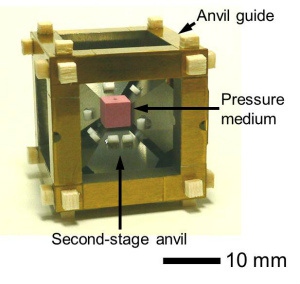  |
| Fig. (1st) A multianvil 6-6 assembly (Kawazoe et al., 2010 HPR). (2nd) A cell assembly used for a deformation experiment on ringwoodite at 20 GPa and 1700 K (Kawazoe et al., 2010 JES). |
|
2. Miniature Multianvil Apparatus for Optical Measurements |
|
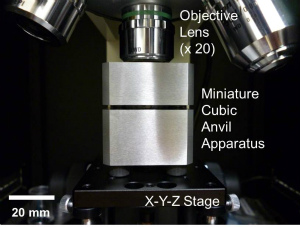 |
I have developed a miniature multianvil apparatus for optical measurements under high pressure. Stress magnitude of a deforming sample may be measured by optical measurements. Please go to a page for a multianvil apparatus for more information. |
III. High-Pressure Synthesis of Deep Mantle Minerals
I have synthesized the deep mantle minerals (high-pressure minerals; wadsleyite, ringwoodite, hydrous ringwoodite, bridgmanite, majorite, etc.) by high-pressure synthesis using a Kawai-type multianvil apparatus. The synthesized minerals are going to be used as starting materials of mineral-physics experiments to study their rheological properties as follows: ・Atomic diffusivity ・Creep properties |
 |
IV. Research Highlight
| □ Coupled Substitution of Fe3+ and H+ for Si in Wadsleyite (Kawazoe et al., in press) | ||
| 【Geophysical implication】 【Result】 We observed protonation of silicate oxygen and presence of Fe3+ at the tetrahedral site. These facts indicate coupled substituion of Fe3+ and H+ for Si in wadsleyite. 【Main method】 ・Polarized infrared spectroscopy ・Moessbauer spectroscopy ・Single-crystal X-ray diffraction ・Kawai-type multianvil apparatus |
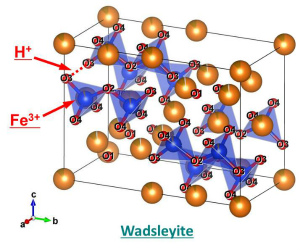 |
|
| □ Dislocation Structure in Deformed Wadsleyite (Miyajima and Kawazoe, 2015) | ||
【Geophysical implication】 The [001](010)-type CPO pattern of wadsleyite is formed by partial dislocations of 1/2<-101>(010) and 1/2<101>(010). 【Result】 ・The partial dislocations of 1/2<-101>(010) and 1/2<101>(010) are the most activated in deformed wadsleyite. 【Main method】 ・Transmission electron microscopy (Weak-beam dark-field method) ・Deformation-DIA multianvil apparatus |
-M180-TEM-WBDF-EN 300px.jpg) |
|
| □ Large Wadsleyite Single Crystals (Kawazoe et al., 2015) | ||
| 【Geophysical implication】 The following studies on wadsleyite become possible: ・Anisotropy of physical properties (e.g. creep strength) ・Difference in physical properties at grain inside and grain boundary 【Result】 ・Large single crystals of wadsleyite were successfully synthesized. 【Main method】 ・Kawai-type multianvil apparatus |
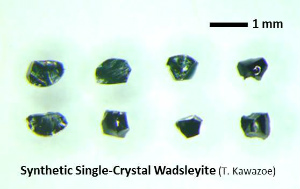 Fig. Single crystals of wadsleyite. |
|
| □ A Review on Recent Advances in Deep Mantle Rheology (Kawazoe, 2014, in Japanese) | ||
I reviewed on recent advances in deep mantle rheology. Our research results were selected as cover figures. 【Content】 ・Observation on mantle deformation by global gravity measurement ・Anisotropic structure of the deep mantle by seismological analysis ・Pressure range of strain-rate-controlled deformation experiments Fig. A journal cover of The Review of High Pressure Science and Technology (in Japanese), volume 24, No. 2. |
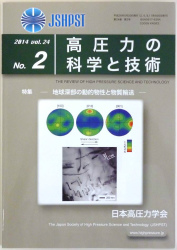 |
|
| □ Seismic Anisotropy in the Mantle Transition Zone (Kawazoe et al., 2013) | ||
| 【Geophysical implication】 ・Interpretation of seismic anisotropy at the upper mantle transition zone ・Horizontal flow is dominant at the region. 【Result】 ・CPO pattern of wadsleyite was determined. 【Main method】 ・Deformation-DIA multianvil apparatus ・Electron backscatter diffraction (EBSD) |
 Fig. A CPO pattern (pole figures) of the deformed wadsleyite. |
|
| □ Deformation of Ringwoodite at P-T Conditions of the Transition Zone (Kawazoe et al., 2010 JES) | ||
【Geophysical implication】 Anisotropic structure at the lower mantle transition zone may not be explained by ringwoodite CPO. 【Result】 ・Expansion of the P-T conditions in the deformation-DIA apparatus to 20 GPa and 1700 K ・Ringwoodite CPO pattern did not clearly develop at 9 % strain. 【Main method】 ・Deformation-DIA multianvil apparatus ・Electron backscatter diffraction (EBSD) Fig. (Upper) A photograph of ringwoodite deformed at 20 GPa and 1700 K. (Lower) A CPO pattern of rinwoodite. |
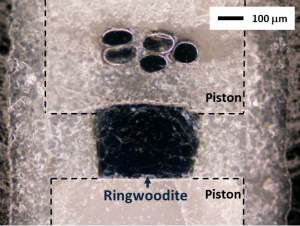  |
|
| □ Pressure Generation to 25 GPa Using a Cubic Anvil Apparatus (Kawazoe et al., 2010 HPR) | ||
【Result】 ・A pressure range available in the cubic anvil multianvil apparatus was extended to 25 GPa. 【Main method】 ・Cubic anvil multianvil apparatus ・Resistance measurement 【Point】 ・Hardest tungsten carbide anvil ・High-precision anvil alignment (Multianvil 6-6 system) Fig. Electrican resistance of GaP showing pressure generation over 24 GPa. |
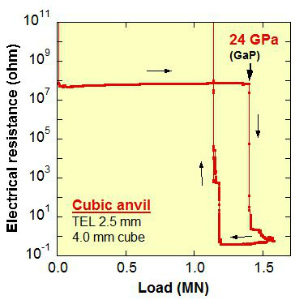 |
|
| □ Wadsleyite Viscosity (Kawazoe et al., 2010 JGR) | ||
| 【Geophysical implication】 ・Viscosity at the upper mantle transition zone is comparable with that of the deep upper mantle (at water-poor condition). 【Result】 ・Creep strength of wadsleyite is comparable with that of olivine. (at water-poor condition) 【Main method】 ・Rotational Drickamer apparatus ・In situ stress-strain measurements (with synchrotron X-ray) Fig. Creep strength of wadsleyite as a function of temperature at 14-17 GPa. |
 |
|
| □ Olivine Viscosity with Depth (Kawazoe et al., 2009) | ||
【Geophysical implication】 ・Viscosity at the upper mantle increases with depth. (at water-poor condition) 【Result】 ・Creep strength of olivine increases with pressure. (at water-poor condition) 【Main method】 ・Rotational Drickamer apparatus ・In situ stress-strain measurements (with synchrotron X-ray) Fig. Creep strength of olivine as a function of pressure and temperature. |
 |
|
| □ Reaction Between Liquid Iron and Bridgmanite (Kawazoe and Ohtani, 2006) | ||
【Geophysical implication】 ・Si and O are strong candidates of light elements in the Earth's core. 【Result】 ・Bridgmanite (Mg-perovskite) reacts with liquid iron at high T. ・Liquid iron contains Si and O because of the reaction. 【Main method】 ・Kawai-type multianvil apparatus ・EPMA with wave-dispersive mode Fig. Composition maps and a backscattered electron image of a quenched liquid iron. Si-O rich parts are quench crystals of stihovite. |
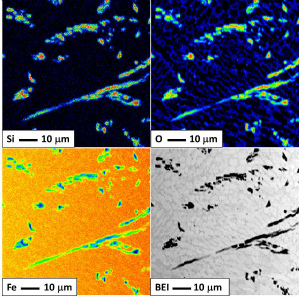 |
|
Copyright (c) Since 2012. Takaaki KAWAZOE. All Rights Reserved.